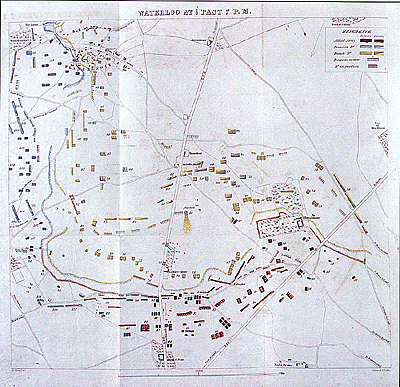Peer Pressure
Wellington, Siborne, and the Waterloo
Search for Information
by Peter Hofschroer, Austria
| |
Towards the end of 1834, Siborne approached the Horse Guards for information. [1]
Map of the Large Model, as exhibited in 1838. Shown from a south to north perspective, the battle is shown as at around 7.15 p.m. Approximately in the centre of the map, the retreating columns of the first two battalions of the Imperial Guard can be seen breaking up into disorder, while the five remaining columns, further to the right and lower down, are in the process of being enfiladed by the British line. The Prussian intervention at Plancenoit, top left, is in full swing.
Sir James Willoughby Gordon, Quartermaster-General there, commented it would make
more sense for Siborne to show the positions of troops ‘at the commencement of the action, when each successive movement could best be followed up by an attentive study of the Duke’s
Despatch’, otherwise the Model would ‘weaken the high authority
of the Duke’s Despatch’. [2]
Siborne’s response was to justify his decision to portray the crisis of the battle. Furthermore, Siborne assured the Horse Guards that his Model ‘will contain nothing at
variance with one syllable’ of Wellington’s Despatch and that he did not intend ‘to fasten a single figure’ upon the Model without submitting it ‘for His Grace’s approval and correction’. [3]
Sir Robert Hussey Vivian, commander of a cavalry brigade at Waterloo and now Commander-in-Chief Ireland, supported Siborne’s decision. Vivian drew Siborne’s attention to the fact that by
showing the last stages of the battle, he would have to include the Prussians. [4]
The incorporation of the Prussian forces would later
adversely affect Siborne’s relationship with Wellington.
Siborne laboured away at his Model. Two years later, on
6 September 1836, he wrote to FitzRoy Somerset, enclosing
a plan of the Model with the positions of the troops marked.
Siborne, an honourable man, kept his word about seeking
Wellington’s approval of the positions of the troops on the
Model. He requested FitzRoy Somerset to forward it to
Wellington to allow the Duke to make ‘any corrections or
alterations which His Grace may feel disposed’. [5]
Wellington then wrote an internal Memorandum on Siborne’s Plan,
commenting, ‘I have looked over the plan of the ground of
the battle of Waterloo, which appears to me to be accurately
drawn. It is very difficult for me to judge the particular
position of each body of troops under my command, much
less of the Prussian army, at any particular hour. ’ [6]
This Memorandum was not passed on to Siborne.
Instead, on 26 October 1836, Lt. Col. Lindsay wrote to
Siborne from the Horse Guards urging Siborne attend an
interview with Wellington.
He wrote, ‘Lord FitzRoy Somerset appears to have placed your
Papers in the hands of the D. of W. - and from what I can
gather it is clear he (Lord FRS) is solicitous to converse with
you upon some points which are very material to the perfect
accuracy of your Plan - especially touching the share the
Prussians actually had in deciding the Battle - I therefore
write - earnestly - to press your coming here - and as it may
lead to your having an interview with the D. it will be as
well that you should be prepared accordingly.
‘Let me hear by return of Post that it is convenient for
you to come - and the sooner the better as you may catch
the Duke either on his way through Town - or at Walmer
[Castle] where you might have the assistance & advice of
Lord FitzRoy before hand.
‘Keep the object of your Journey quiet but believe me
you will do well to come.’ [7]
Between Wellington seeing Siborne’s Plan in September,
then his rather bland commentary on it early October, and
Lindsay’s letter of the end of the month, something seems to
have occurred that required Siborne to make an urgent and
secret journey to London for a meeting with Wellington in
person. We may ask: Why was this letter written and what
did the Duke intend to achieve at this meeting?
Peer Pressure Wellington, Siborne, and the Waterloo
|

